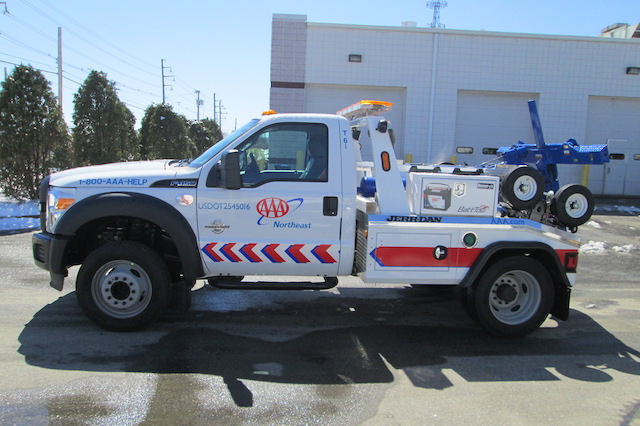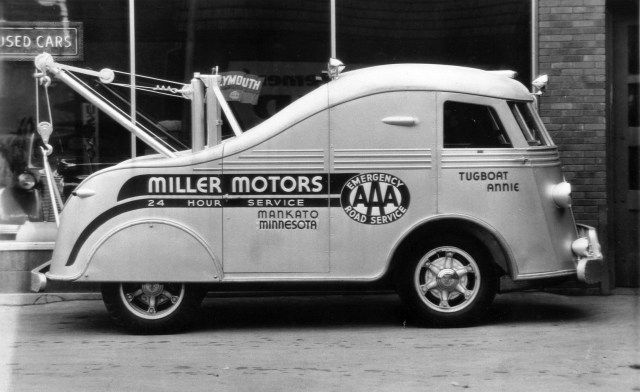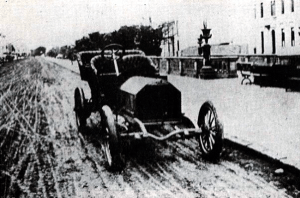A tow truck is one thing we hope to never need, but when we do, we’re sure glad it exists. These helpful vehicles – and the men and women operating them – get us out of tricky situations when we’re in dire straits.
Considering their usefulness and importance, it might be strange to know there was a time in automotive history when tow trucks didn’t exist. After all, as long as there have been cars, there have been crashes and breakdowns requiring the transportation of disabled vehicles.
Yet tow truck history didn’t begin until well into the 20th century. Once the first was manufactured, however, they quickly became ubiquitous.
The Tow Truck Arrives
Tow truck history can be traced back to one fateful day in 1916. Ernest Holmes, Sr., a mechanic in Chattanooga, Tenn., received news that a motorist had lost control of their Ford Model T and driven into a creek. Holmes went down to the site of the crash to recover the vehicle. Having little more than some rope and blocks at their disposal, it took six men eight hours to get the Model T out of the water and back onto the road.
The experience convinced Holmes that there had to be a more efficient way to move disabled cars. He went back to his shop and began constructing what would eventually become the first tow truck. To do so, Holmes mounted a chain and pulley system onto the chassis of a 1913 Cadillac. He would later improve the design with the addition of two outriggers, which helped stabilize the towed car when it was being hoisted off the ground. In 1918, Holmes was awarded a patent for his invention.

The Towing Industry Is Born
With automobile ownership on the rise, Holmes knew the need for tow trucks, or wreckers as they were known, would only grow. He transformed his auto shop business into a manufacturing operation and went to work building and selling these new vehicles.
His first commercially available model was the Holmes 485. This improved version utilized the longer body of a 1913 Locomobile. Considered by many to be the best American-made car of its time, a new Locomobile was selling for $6,000, or roughly $100,000 today.
With a patent in tow and production underway, Holmes was on his way to creating a highly successful business. He supplied the U.S. Army with thousands of military wreckers during World War I and II. When NASCAR came onto the scene, Holmes’ wreckers became a common sight at the racetrack. By 1965, two-thirds of all wreckers in the tow truck industry were Holmes models, according to the Chattanoogan.
Holmes continued to tinker with his initial design in the proceeding years and decades, garnering roughly a dozen more patents. He also invented several new vehicle lifts, creepers and jacks. His brand of trucks still exists today.
For his work, Holmes was inducted into the University of Tennessee Chattanooga’s Entrepreneurship Hall of Fame and the International Towing Museum Hall of Fame, which is located in his hometown of Chattanooga.

Modern Tow Trucks
Although the general manner in which tow trucks work has remained the same since Holmes’ day, wreckers have become stronger, more effective and equipped with new features. There are three primary types of tow trucks used on passenger cars today:
- Flatbed: As the name implies, these trucks have large flatbeds capable of fitting an entire car. The operator tilts the flatbed toward the ground using hydraulics and the car is driven or pulled onto the platform. The bed is then lifted back into position, the car is secured and the truck is ready to move. Flatbeds are generally considered the safest and easiest way to transport a car because there’s no pressure on the towed vehicle or any chance it could get dragged along the road.
- Hook and Chain: These tow trucks employ heavy-duty chains that attach to one end of the disabled car. The chain is then pulled, lifting the car in the air and leaving only two wheels on the ground. The vehicle is transported while in this position. The hook and chain truck leaves the towed car susceptible to damage, so it’s typically only used on wrecked cars or those in poor condition. They can also be utilized to pull a car out of a stuck position, such as a ditch or mud patch.
- Wheel Lifts: Like the hook and chain, wheel lifts tow cars with only two wheels in contact with the street. But instead of a shaky chain, wheel lifts utilize a metal yoke to lift the car. This feature puts less strain on the towed vehicle and provides a more stable attachment, reducing the likelihood of damage occurring during transport.
AAA may not have invented the tow truck, but it has perfected the use of it. Roadside Assistance is available to members 24/7, 365 days a year, including towing services. Simply call or request assistance through the AAA mobile app, and a technician will be on their way.
If you ever see a tow truck in operation, remember to Slow Down, Move Over. It’s the law.
Learn more about automotive history.
5 Thoughts on “The History of the Tow Truck”
Leave A Comment
Comments are subject to moderation and may or may not be published at the editor’s discretion. Only comments that are relevant to the article and add value to the Your AAA community will be considered. Comments may be edited for clarity and length.














Thank you so much for this detailed history of the tow truck…or wrecker. I was interested in learning about at what point the tow truck became used as a tool to steal other peoples vehicles. From my understanding, the tow truck, or wrecker, was intended to move vehicles from traffic that had been in an accident. Or to move vehicles that were not working properly to a place where they could be serviced. I think at some point in history, a person decided to manipulate a business owner into believing that another person who had the misfortune of their vehicle running out of gas or breaking down in their parking lot was an act of malicious intent by the car owner. This person who was able to manipulate the business owner, very clearly, had a bad reputation or simply could not do his job as well as the other tow truck drivers, to the point that he had to go the “evil” route and use manipulation tactics. Some might say this is ingenious, but in fact…the sole purpose is to take advantage of those in a bad position without any sense of care at all for those whos lives might be ruined by the loss of their vehicle. People like that need to be called out amongst those who do not wish to see the bad guys win in our society!
Back in 1988, an older fellow, a Wichita Auto Dealer, at that time told me a story of his first adventures into the Auto Business. I assume he was referring to the 1940’s or 1950’s. His story:
He would buy a few cars in Oklahoma and Texas. Having gathered maybe three to 5 cars, he would attach them in tandem and then tow them to California for resale to Auto Dealers there.
He described how he would tow with one of the cars until it ran low on fuel, then he would put that vehicle in the tandem rotation and then tow with another of the cars. He would do this all the way to California.
I tried to find some pictures on the internet: pics of maybe 4 or five cars being caravan-ed in tandem probably with the aide of tow-bars.
I find no pics, but i feel this was probably a common practice back in the day. Leo
Thats awesome!
In Europe and/or Israel, I saw a different type of flat bed tow truck. The ones I saw put the truck on the side of the car, then maneuvered arms under the car, then hydraulically lifted the car onto the flatbed. I don’t recall how the truck was anchored while the car was lifted. The advantage of this type of flatbed tow truck is that it can be used to move cars that are parked among other cars on the side of a street.
Hi Phil, thanks for reading Your AAA Network and for your comment. That’s really remarkable, quite a tow truck configuration. I guess it makes sense for tightly packed cities, I can see where side-loading would come in handy here in new york for instance. Interesting stuff, thanks again!